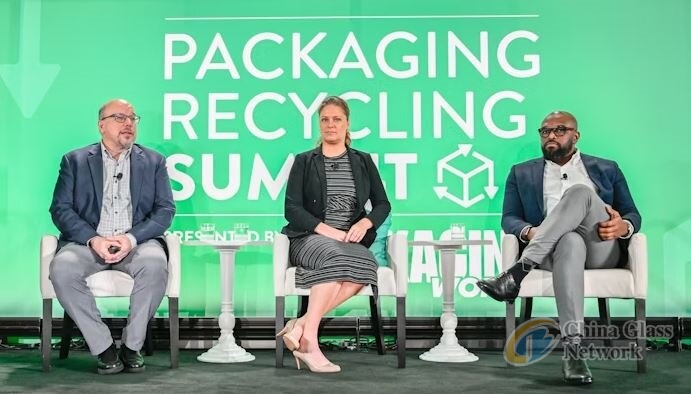Post Time:Oct 30,2024Classify:Industry NewsView:1203
(l. to r.) Scott DeFife, president of the Glass Packaging Institute (GPI), Laura Hennemann, senior VP of Sustainability & Corporate Affairs at SMI, and Gabriel Opoku-Asare, director of Society/ESG at Diageo North America.

While plastic often makes up the lion’s share of any conversation on recycling, another material worthy of attention is glass, which, while infinitely recyclable, is only recycled at a rate of roughly 31% in the U.S. That’s according to Scott DeFife, president of the Glass Packaging Institute (GPI). DeFife recently participated in a panel, along with Laura Hennemann, senior VP of Sustainability & Corporate Affairs at North America’s leading glass recycler, SMI, and Gabriel Opoku-Asare, director of Society/ESG at Diageo North America, at Packaging World’s Packaging Recycling Summit.
DeFife also noted that data from Europe and other developed nations that have solid glass recycling systems shows that it is possible to recover from 50 to 90% of glass. “The more glass that is recovered, the more we can turn it back into new bottles,” he said. “So five years ago, the industry came together and set a goal for the 2030 time period of getting to 50% recycling rates.”
As he explained, glass offers unique recycling opportunities and challenges. Glass is used as primary packaging for the food, beverage, and personal care industries in particular, with beer making up 47% of the market share of U.S. glass container shipments by category, followed by food at 24%. Wine and spirits make up 8% and 6%, respectively.
“So glass follows people,” DeFife said. “And, if you track back to where the markets for glass are in the first place, a majority of the glass is beverage alcohol, and where is beverage alcohol? It’s in the hospitality industry.” That’s in contrast to other packaging materials, which are more often disposed of at curbside.
He added that “glass could and should be recycled.” Among the benefits, it makes up 17% to 27% of a MRFs incoming recycling stream (by weight), MRF fees typically cover the sorting of all materials, proper capture and cleaning of glass results in low cross contamination, and glass has the lowest variable cost.
Hennemann, whose recycling company processes 2.4 million tons of material, primarily glass, each year, said, “Why do our customers use recycled content other than that it makes everybody feel really good and has a great story? They have a lower emissions savings because when you use recycled content versus a virgin material, it melts at a lower temperature, so therefore they see the savings. It's also is better for their equipment long-term, because they’re not running their furnaces as hard and as hot.”
Hennemann also debunked common myths around glass recycling, such as:
· Broken glass cannot be accepted curbside. “It can.”
· Mixed, colored glass cannot be accepted. “It can.”
· Glass must be washed and cleaned before being put in the bin. “It’s not problematic if you don’t wash and clean it, but it’s the polite thing to do.”
· Glass contaminates all the recyclables. “In a single stream, everything contaminates everything else.”
Providing a voice for brand owners was Opoku-Asare, who shared that Diageo has committed to achieving 60% recycled content in all its packaging by 2030.
To help create glass packaging that is more recyclable, the company has begun making design changes to its bottles. “We know that things like a large bottle base cause a lot of problems on conveyors and also on the crushers as well, so we are working to lightweight the base of the bottle,” he said. “We also understand the impacts of decoration when it comes to bottle recycling.”
To support and catalyze the glass recycling infrastructure, Diageo is meeting the customer where they’re at, literally, by partnering in the Don’t Trash Glass program, spearheaded by GPI. Piloted in Chicago, where there are considerable MRF glass-recycling capabilities, the Don’t Trash Glass initiative provides separate bins for 68 bars and restaurants to dispose of their glass containers for recycling.
“From the point where the customer consumes the beverage to the time that the glass is made into a new bottle is around two weeks,” said Opoku-Asare. “In the first year of the pilot, we were able to collect around 2.2 million tons of glass.”
Following the the success of the program, Diageo is expanding its partnership in the program to Kentucky.
Diageo has also joined the Recycle World Partnership, a $350 million initiative to drive glass recycling in Kentucky. Through WorkWell Industries, the initiative will collect clean flint glass bottles from regional distilleries, tasting rooms, and bottling facilities to crush into glass cullet and return to glass manufacturing facilities to be produced into new glass bottles.
“This program meets our mission to be more sustainable by 2030. For us, we are looking at long-term supply chain resilience,” explained Opoku-Asare. “In the future, if glass is going through the circular loop, we can guarantee consistent supplies for us. Also, if you look at the bars and restaurants within our chain, this is good for them to improve their own carbon footprint as well. So this is a clear carbon strategy for us.”
Source: www.packworld.comAuthor: shangyi